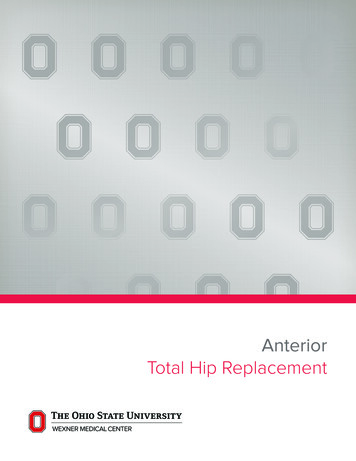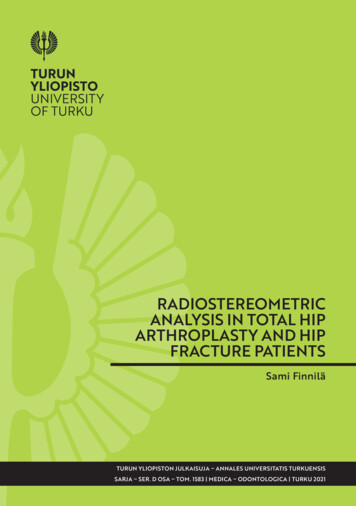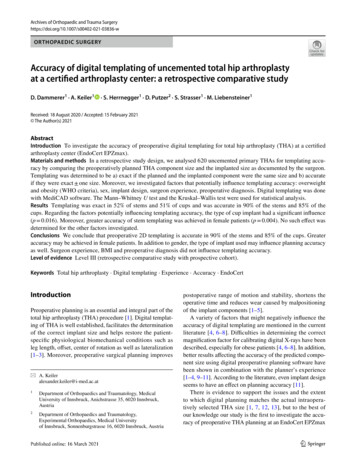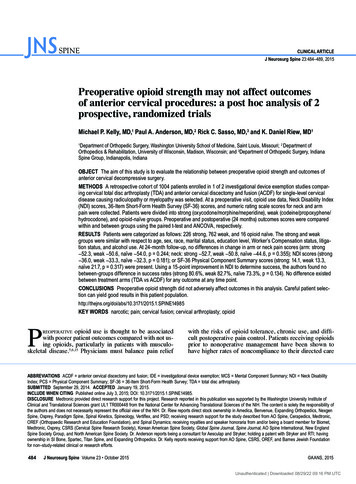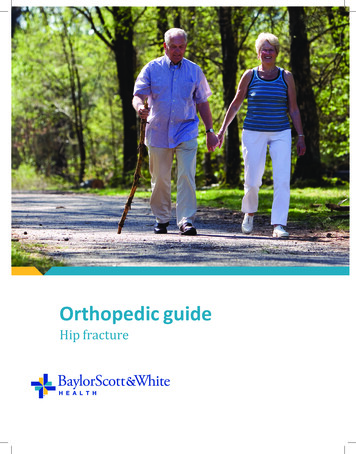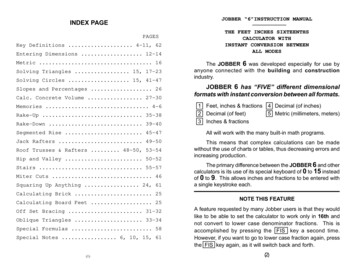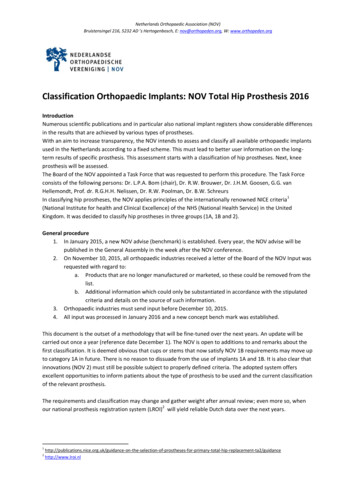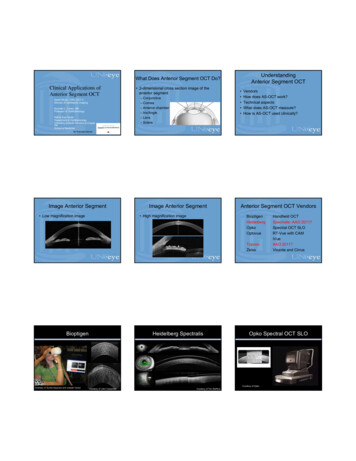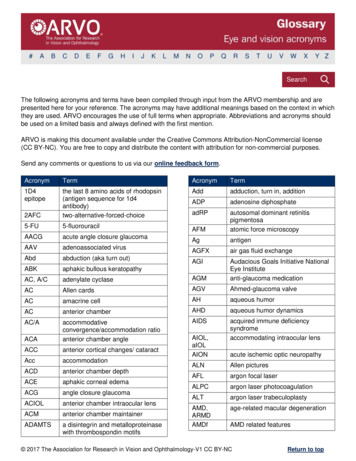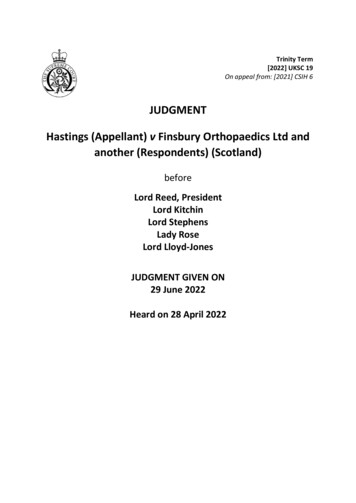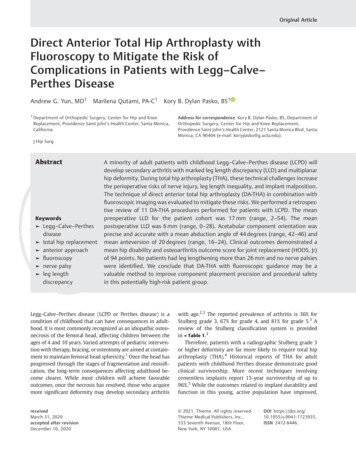
Transcription
Original ArticleDirect Anterior Total Hip Arthroplasty withFluoroscopy to Mitigate the Risk ofComplications in Patients with Legg–Calve–Perthes DiseaseAndrew G. Yun, MD1Marilena Qutami, PA-C1Kory B. Dylan Pasko, BS11 Department of Orthopedic Surgery, Center for Hip and KneeReplacement, Providence Saint John’s Health Center, Santa Monica,CaliforniaAddress for correspondence Kory B. Dylan Pasko, BS, Department ofOrthopedic Surgery, Center for Hip and Knee Replacement,Providence Saint John’s Health Center, 2121 Santa Monica Blvd, SantaMonica, CA 90404 (e-mail: korypasko@g.ucla.edu).J Hip SurgAbstractKeywords Legg–Calve–Perthesdisease total hip replacement anterior approach fluoroscopy nerve palsy leg lengthdiscrepancyA minority of adult patients with childhood Legg–Calve–Perthes disease (LCPD) willdevelop secondary arthritis with marked leg length discrepancy (LLD) and multiplanarhip deformity. During total hip arthroplasty (THA), these technical challenges increasethe perioperative risks of nerve injury, leg length inequality, and implant malposition.The technique of direct anterior total hip arthroplasty (DA-THA) in combination withfluoroscopic imaging was evaluated to mitigate these risks. We performed a retrospective review of 11 DA-THA procedures performed for patients with LCPD. The meanpreoperative LLD for the patient cohort was 17 mm (range, 2–54). The meanpostoperative LLD was 6 mm (range, 0–28). Acetabular component orientation wasprecise and accurate with a mean abduction angle of 44 degrees (range, 42–46) andmean anteversion of 20 degrees (range, 16–24). Clinical outcomes demonstrated amean hip disability and osteoarthritis outcome score for joint replacement (HOOS, Jr)of 94 points. No patients had leg lengthening more than 26 mm and no nerve palsieswere identified. We conclude that DA-THA with fluoroscopic guidance may be avaluable method to improve component placement precision and procedural safetyin this potentially high-risk patient group.Legg–Calve–Perthes disease (LCPD or Perthes disease) is acondition of childhood that can have consequences in adulthood. It is most commonly recognized as an idiopathic osteonecrosis of the femoral head, affecting children between theages of 4 and 10 years. Varied attempts of pediatric intervention with therapy, bracing, or osteotomy are aimed at containment to maintain femoral head sphericity.1 Once the head hasprogressed through the stages of fragmentation and reossification, the long-term consequences affecting adulthood become clearer. While most children will achieve favorableoutcomes, once the necrosis has resolved, those who acquiremore significant deformity may develop secondary arthritiswith age.2,3 The reported prevalence of arthritis is 36% forStulberg grade 3, 67% for grade 4, and 81% for grade 5.3 Areview of the Stulberg classification system is providedin Table 1.3Therefore, patients with a radiographic Stulberg grade 3or higher deformity are far more likely to require total hiparthroplasty (THA).4 Historical reports of THA for adultpatients with childhood Perthes disease demonstrate goodclinical survivorship. More recent techniques involvingcementless implants report 15-year survivorship of up to96%.5 While the outcomes related to implant durability andfunction in this young, active population have improved,receivedMarch 31, 2020accepted after revisionDecember 10, 2020 2021. Thieme. All rights reserved.Thieme Medical Publishers, Inc.,333 Seventh Avenue, 18th Floor,New York, NY 10001, USADOI https://doi.org/10.1055/s-0041-1723935.ISSN 2472-8446.
Risk of Complications in Patients with Legg–Calve–Perthes DiseaseTable 1 Stulberg classification criteriaClassFeaturesRadiographic findingsINormalhip jointSpherical headIISphericalcongruencyLoss of headshape 2 mmSpherical headWith 1 abnormality- Coxa magna- Steep acetabulum- Shortened femoral neckIIIAsphericalcongruencyLoss of headshape 2 mmMushroom- or umbrella-shapedfemoral head; not flatWith 1 abnormality- Coxa magna- Steep acetabulum- Shortened femoral neckIVAsphericalcongruencyFlat femoral head andacetabulumVAsphericalincongruencyFlat femoral head, normalneck and acetabulumSource: Adapted from Stulberg et al.3Yun et al.copy would potentially mitigate the risks of implant malposition, leg length inequality, or postoperative nerve injuryamong patients with LCPD.Methods and MaterialsWe retrospectively reviewed a total of 11 THAs in 10 patientswith LCPD who underwent DA-THA between 2013 and 2019.Surgery was performed by a single surgeon at a singleinstitution with a minimum of 1-year follow-up. Onlypatients who had a direct anterior (DA) approach wereincluded. Patients with a history of prior pelvic or femoralosteotomy were not included.All patients reported a childhood history of LCPD. Chartswere reviewed for indications, medical history, and mode oftreatment failure. Hospital records were reviewed for complications, reoperations, and readmissions. Outcomes measured were patient-reported hip disability and osteoarthritisoutcome score for joint replacement (HOOS, Jr), revision, anddeath.8 All patients consented to participate in the database.The study was approved by the Institutional Review Board.Surgical TechniqueFig. 1 Characteristic multiplanar deformity in Stulberg IV hip withfemoral head flattening, abnormally steep acetabulum, and leg lengthdiscrepancy.there are still serious concerns related to immediate perioperative complications.LCPD patients with secondary arthritis exhibit deformity inevery key structure affecting arthroplasty: acetabular dysplasia, high hip center, coxa magna, trochanteric overgrowth, coxabreva, and leg length inequality ( Fig. 1). Intraoperativechallenges related to the characteristic deformity of LCPDintroduce the risks of overlengthening, implant malposition,and neurologic injury. The perioperative risk of sciatic nerveinjury in patients with LCPD has been reported to be as high as6% in smaller series and up to 3% more broadly in a metaanalysis, compared with a risk of 0.17% in patients withprimary osteoarthritis.5–7 While the etiology of nerve palsyin these patients is variable, it is likely related to overstretchingthe nerve during unexpected excessive lengthening.5We routinely perform direct anterior total hip arthroplasty (DA-THA) utilizing intraoperative fluoroscopy. Weperformed this study to assess whether the use of fluorosJournal of Hip Surgery 2021. Thieme. All rights reserved.The patient was placed on the Hana table in the standardfashion. A DA approach was performed as described byMatta.9 In more severe deformities with dysplasia, lateralsubluxation and coxa breva, fluoroscopy was used prior toincision to locate the appropriate starting point. Dissectionwas taken to the level of the hip. After capsulotomy, the headwas removed in the standard fashion.Attention was turned to the acetabulum. Preoperative templating was used to locate an acetabular cup position withsufficient bone support and a corrected center of rotation (COR).This location was often inferior and medial to the starting CORand was identified intraoperatively using fluoroscopic guidancewhen positioning the reamer. A modified medial protrusiotechnique (MPT) as described by Eskildsen et al was used tocreate sufficient superolateral coverage for cup stability andingrowth but without fracturing the medial wall.10 The technique deepens the reaming directly toward the medial wall, andcup sizing is dependent on the fit between the anterior andposterior columns, to avoid a high hip center and vertical cupplacement. Because of the distorted anatomy characteristic ofLCPD, the cup was placed under fluoroscopic navigation toenable real-time adjustments to abduction, anteversion, height,depth, and bone coverage. A modular cementless, titanium,hemispherical, acetabular shell (Reflection 3 [Smith & Nephew]prior to 2018; Trident II [Stryker] from 2018) was used with aneutral, highly cross-linked, fixed bearing polyethylene liner toaccommodate the largest femoral head.On the femoral side, the affected hip presented with awidened, flattened head with decreased hip length. Preoperative and intraoperative templating was used to estimate theamount of combined leg length correction from the acetabulum and the head-neck-stem construct. With the trials in place,fluoroscopy was used to identify any increase in hip lengthbeyond the planned correction, and adjustments were madeaccordingly ( Fig. 2). Given the preoperative leg length
Risk of Complications in Patients with Legg–Calve–Perthes DiseaseYun et al.two women. One of the men had bilateral LCPD and underwent staged DA-THA. Using the Stulberg classification, therewere two class II, four class III, and five class IV patients.3 Nopatient had undergone prior surgical correction.The mean time to follow-up for surviving patients was 3.3years (range, 1 to 6). The mean HOOS, Jr was 94 (range, 81–100).At final follow-up, there were no perioperative fractures, nerveinjuries, dislocations, infections, readmissions, or revisions.There was one death 28 days after surgery following an uncomplicated hospital course and discharge to home on postoperativeday two. The patient was 67 years old with a history of stablecoronary artery disease, prior myocardial infarction, and drugmisuse. The cause of death was unknown but assumed to bepulmonary embolism, sudden cardiac death, or overdose,according to the primary care doctor.Radiographic OutcomesFig. 2 Intraoperative imaging. The pelvis is leveled with a sacral linebisecting the pubic symphysis. Bilateral hips are in symmetric rotation andabduction. Leg length is measured in relation to the interteardrop line.inequality, care was taken not to lengthen the hip beyond thecontralateral side in an effort to avoid excessive tension on theneurovascular structures. The trials were clinically tested forstability, range of motion, and impingement before the finalimplants were placed. A standard length cementless titaniumstem using a triple taper hydroxyapatite-coated design (Corail[DePuy Synthes]) was used for all patients.In this series, patients were allowed to progress withweight-bearing as tolerated and without dislocation precautions. Patients were anticoagulated with aspirin for 3 weeksunless stronger anticoagulation was specifically indicated,based on risk stratification, degree of immobility, and priormedical history.Radiographic MeasurementPreoperative radiographs were reviewed for severity of LCPDand were staged according to the Stulberg classification.3Preoperative leg length and inequality were compared withpostoperative measurements. Leg length was determined bythe vertical distance from a specified point on the lessertrochanter to a horizontal line drawn from the bottom ofeach radiographic teardrop. Inequality was calculated by thedifference in hip lengths between the index side and thecontralateral side. Offset was calculated as the horizontaldistance from the same point on the lesser trochanters to themost lateral edge of the ischium. Postoperative radiographswere evaluated for cup orientation, amount of lengthening,and postoperative leg length inequality. Anteversion wascalculated using the angle of the opening of the ellipse, ascalculated by the Radlink software (El Segundo, CA).ResultsThe average age of patients at the time of index surgery was57 years (range, 31 to 81). Patients included eight men andThe average acetabular abduction angle was 44 degrees(range, 42 to 46), and the average anteversion was 20 degrees(range 16 to 24). The average amount of preoperative limblength inequality was 17 mm (range, 2 to 54) of shortening.The average amount of postoperative limb length inequalitywas 6 mm (range, 0 to 28). The average amount of operativelimb lengthening was 11 mm (range, 0 to 26). Ten of thepatients were lengthened between 0 and 18 mm, and onepatient was lengthened 26 mm. This patient started with a54 mm discrepancy, and it was decided preoperatively tolimit the correction to 25 mm as a neuroprotective measure.No hip was lengthened beyond the contralateral side. Theaverage offset preoperatively was 22 mm (range, 19 to 32)with the pelvis level. Postoperatively, the average offset was20 mm (range, 13 to 28).DiscussionWhile modern THA has proven to be an effective and durabletreatment for secondary arthritis in LCPD, the immediateperioperative risks of sciatic nerve palsy and excessive leglengthening remain an ongoing concern. The technical challenges of leg shortening, joint incongruity, and multiplanardeformity create unique risks when placing implants. Thepurpose of this study was to evaluate the specific techniqueof DA-THA with fluoroscopy as a tool to decrease the risk ofexcessive lengthening and consequent nerve injury in thisspecific patient population.Patients with LCPD frequently present with a developmental leg length discrepancy (LLD). In the absence ofnormal skeletal growth, the surrounding neurovascular bundle and soft tissues are developmentally shorter as well.While stretching the tissues beyond their physiologicaladaptability is to be avoided, the actual amount of lengthening the sciatic nerve can tolerate is unclear. Edwards et alwarned of a greater risk beyond 4 cm of lengthening, although complications were noted beyond 2.2 cm.11Whereas there is a 0.17% risk of sciatic injury in THA forosteoarthritis overall, the risk for LCPD patients is substantially higher.7 Several series have reported rates of perioperative nerve palsy between 3 and 6%.5,12,13 UsingJournal of Hip Surgery 2021. Thieme. All rights reserved.
Risk of Complications in Patients with Legg–Calve–Perthes DiseaseYun et al.Fig. 3 Confirming cup position and trial implants. (A) Preoperative Stulberg IV with 16 mm of shortening and high hip center. (B) Intraoperativeimaging used to evaluate cup height, depth and orientation and the comparative length of the stem-neck-head construct.conventional methods without fluoroscopy, Baghdadi et alreported neurological complication in 3 of 99 cases.13 Thesethree cases were lengthened a mean of 2.2 cm, in contrast tolengthening of 1.4 cm in those without neurologic injury. Luoet al reported sciatic nerve palsy in 2 patients lengthened3.1 cm and 3.6 cm.12 Traina et al attributed a neurologicalcomplication rate of 6% to excessive limb lengthening.5Perhaps because the mean lengthening of our cohort was11 mm, there were no neurological injuries. Moreover, weintentionally attempted to limit correction to less than2.5 cm, in order to mitigate the risk of nerve stretch.Intraoperatively, measuring the exact amount of lengthening in LCPD with conventional methods is challenging. InLCPD, lengthening is related to changes in both the acetabular COR and the head-neck length. Typically, only the changein femoral length can be measured. The change in position ofthe acetabular COR cannot be measured reliably. Consequently, restoring the appropriate leg length is an estimatebased on gross clinical measurements of shuck testing,stability check, and position of the feet.Adjunctive technologies that provide real-time feedbackmay reduce the risk of unanticipated lengthening found onthe postoperative radiograph. Shah et al used computernavigation in two patients to improve leg length equality.14In our series, we found that fluoroscopy offered a reliable wayto calculate and confirm hip length. With the trials in placeand the hip reduced, fluoroscopy was used to confirm thatthe hip was not excessively lengthened, and that a paradoxical inequality with the contralateral hip was avoided( Fig. 3). Any radiographic evidence of excessive lengthening was immediately corrected.Applying this method in our small series, the starting LLDwas improved in all cases ( Fig. 4). The mean increase incombined hip length was 11 mm (range, 0 to 26). In the onecase with a starting LLD of 5.4 cm, we lengthened the leg by2.6 cm, despite our intention to lengthen less than 2.5 cm.Fortunately, this patient did not have a perioperative nervecomplication. Alternatively, patients with a comparably sizable LLD may be reasonable candidates for femoral shortening osteotomy.15Fig. 4 Managing leg length discrepancy in total hip arthroplasty (THA) for Stulberg IV deformity. (A) Preoperatively, right hip with startingdeformity of 12 mm shortening, coxa magna, coxa breva and acetabular dysplasia. (B) Follow-up radiograph showing cup with restored anatomiccenter of rotation, femoral offset, and 3 mm of shortening.Journal of Hip Surgery 2021. Thieme. All rights reserved.
Risk of Complications in Patients with Legg–Calve–Perthes DiseaseIn addition to providing valuable information regarding leglength, the use of fluoroscopy ensured both accurate andprecise acetabular cup orientation. Patients with Stulberg IIIclass or higher will exhibit changes that distort normal anatomic landmarks. In the acetabulum, for example, a steep slopecan lead to an unintentionally high hip center, a shallow basecan bias toward vertical cup placement for the concern ofcoverage, and a developmental retroversion can misrepresentlandmarks guiding the degree of cup anteversion. Consequently, Traina et al noted that 6 of 32 cups (19%) fell outside theplanned safety zone of 30 to 50 degrees.5 With the use offluoroscopy, our cup abduction angle and anteversion hadprecisely narrow ranges of 4 degrees and 8 degrees, respectively, and were both within the accepted safety zones.Despite the immediate perioperative risks, patients withLCPD fare well in follow-up. Multiple studies report goodclinical outcomes, with mean Harris hip scores (HHS) rangingfrom 87 to 93 (Traina 87.5, Seufert 93, and Baghdadi88).5,13,16 Our study supports these findings.There are several limitations of this study. It is a singlesurgeon’s small retrospective series. Larger numbers ofpatients may reveal a complication profile similar to thatof other series. A second limitation is the variable preoperative leg length discrepancy among subjects, but this is thenature of this complex condition. Another major limitation isthe lack of a control group for comparison. A matched cohortof patients with primary arthritis treated with the DAapproach and fluoroscopy could be compared with thisseries. However, the study would still be substantially undersized to define statistically significant observations andwould most likely require a multicentered study to validatemajor findings. Additionally, patients with primary osteoarthritis do not exhibit the same preoperative deformity orpostoperative risk profile as those with LCPD. Another concern is that a minimum 2-year follow-up is more common,but we chose a minimum 1-year follow-up for analysisbecause the primary endpoints were immediate nerve palsy,cup malposition, and LLD. Finally, with the recent transitionto patient-reported outcome using the HOOS Jr score, apreoperative score was not available for comparison.ConclusionThe sequelae of childhood LCPD may develop into challenging and symptomatic multiplanar deformities many decadeslater. The characteristic malformations in hips with Stulbergclass III and higher changes increase the potential for intraoperative miscalculations and postoperative complications.The historic risks of sciatic nerve injury, LLD, and cupmalposition are comparably higher. Modern techniques, asshown in this series, offer the potential to improve theseoutcomes. While the procedure is not without substantialhealth risks, a DA-THA with the use of fluoroscopy may guideYun et al.the surgeon toward safer and more precise reconstructivechoices when faced with such difficult anatomy.Conflicts of InterestNone declared.References1 Herring JA. The treatment of Legg-Calvé-Perthes Disease. A criti-2345678910111213141516cal review of the literature. J Bone Joint Surg Am 1994;76(03):448–458Ippolito E, Tudisco C, Farsetti P. The long-term prognosis ofunilateral Perthes’ disease. J Bone Joint Surg Br 1987;69(02):243–250Stulberg SD, Cooperman DR, Wallensten R. The natural history ofLegg-Calvé-Perthes Disease. J Bone Joint Surg Am 1981;63(07):1095–1108Froberg L, Christensen F, Pedersen NW, Overgaard S. The need fortotal hip arthroplasty in Perthes disease: a long-term study. ClinOrthop Relat Res 2011;469(04):1134–1140Traina F, De Fine M, Sudanese A, Calderoni PP, Tassinari E, Toni A.Long-term results of total hip replacement in patients with LeggCalvé-Perthes Disease. J Bone Joint Surg Am 2011;93(07):e25Hanna SA, Sarraf KM, Ramachandran M, Achan P. Systematicreview of the outcome of total hip arthroplasty in patients withsequelae of Legg-Calvé-Perthes Disease. Arch Orthop Trauma Surg2017;137(08):1149–1154Farrell CM, Springer BD, Haidukewych GJ, Morrey BF. Motor nervepalsy following primary total hip arthroplasty. J Bone Joint SurgAm 2005;87(12):2619–2625Lyman S, Lee Y-Y, Franklin PD, Li W, Mayman DJ, Padgett DE.Validation of the HOOS, JR: a short-form hip replacement survey.Clin Orthop Relat Res 2016;474(06):1472–1482Matta JM, Shahrdar C, Ferguson T. Single-incision anterior approach for total hip arthroplasty on an orthopaedic table. ClinOrthop Relat Res 2005;441(441):115–124Eskildsen SM, Wilson ZJ, McNabb DC, Olcott CW, Del Gaizo DJ.Acetabular reconstruction with the medial protrusio techniquefor complex primary and revision total hip arthroplasties. JArthroplasty 2017;32(11):3474–3479Edwards BN, Tullos HS, Noble PC. Contributory factors andetiology of sciatic nerve palsy in total hip arthroplasty. ClinOrthop Relat Res 1987;(218):136–141Luo ZY, Wang HY, Wang D, Pan H, Pei FX, Zhou ZK. Monoblocimplants in cementless total hip arthroplasty in patients withLegg-Calve-Perthes Disease: a long-term follow-up. BMC Musculoskelet Disord 2017;18(01):386Baghdadi YM, Larson AN, Stans AA, Mabry TM. Total hip arthroplasty for the sequelae of Legg-Calvé-Perthes disease. Clin OrthopRelat Res 2013;471(09):2980–2986Shah RR, Gobin V, Muir JM. Imageless navigation improvesintraoperative monitoring of leg length changes during totalhip arthroplasty for Legg-Calve-Perthes Disease: two casereports. Case Rep Orthop 2018;2018:4362367Krych AJ, Howard JL, Trousdale RT, Cabanela ME, Berry DJ. Totalhip arthroplasty with shortening subtrochanteric osteotomy inCrowe type-IV developmental dysplasia: surgical technique. JBone Joint Surg Am 2010;92(1, Suppl 1 Pt 2)176–187Seufert CR, McGrory BJ. Treatment of arthritis associated withLegg-Calve-Perthes Disease with modular total hip arthroplasty. JArthroplasty 2015;30(10):1743–1746Journal of Hip Surgery 2021. Thieme. All rights reserved.
96%.5 While the outcomes related to implant durability and function in this young, active population have improved, Keywords Legg-Calve-Perthes disease total hip replacement anterior approach fluoroscopy nerve palsy leg length discrepancy Abstract A minority of adult patients with childhood Legg-Calve-Perthes disease (LCPD) will
